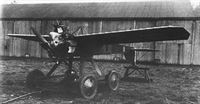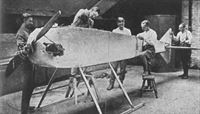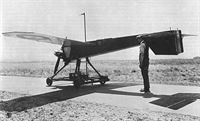Фотографии
-
Experimental ATs were of varied types, including the Sopwith-designed biplane
Самолёты на фотографии: Sopwith Sparrow - Великобритания - 1917
-
Larynx on its launcher aboard HMS Stronghold.
Самолёты на фотографии: RAE Larynx - Великобритания - 1927
-
The RAE Larynx on its catapult aboard HMS Stronghold. The Larynx was powered by a 200 h.p. close-cowled Lynx engine.
Самолёты на фотографии: RAE Larynx - Великобритания - 1927
-
An AT on its launcher aboard HMS Stronghold - AT No 11 may be seen in the foreground.
Самолёты на фотографии: RAF Aerial Target / AT - Великобритания - 1917
-
An AT caught at the moment of launch.
Самолёты на фотографии: RAF Aerial Target / AT - Великобритания - 1917
-
AT No 10 being retrieved following a sea landing.
Самолёты на фотографии: RAF Aerial Target / AT - Великобритания - 1917
-
AT No 11 on its handling trolley. First launch attempts were made from HMS Argus on July 12 and August 31, 1922.
Самолёты на фотографии: RAF Aerial Target / AT - Великобритания - 1917
-
View of a 1917 Royal Aircraft Factory AT, powered by a 35 h.p. ABC Gnat flat twin engine.
Самолёты на фотографии: RAF Aerial Target / AT - Великобритания - 1917
-
The RAE 1922 AT was powered by a 45 h.p. Siddeley-Deasy Ounce engine. This AT had no undercarriage and was launched from a simple track aboard HMS Argus and, later, HMS Stronghold.
Самолёты на фотографии: RAF Aerial Target / AT - Великобритания - 1917
-
The chordwise lines under the wings are aerial wires, not ribs - others were located on the fuselage sides. Interference from the ignition system was a problem.
Самолёты на фотографии: RAF Aerial Target / AT - Великобритания - 1917
-
This Royal Aircraft Establishment side elevation of an Aircraft Target (AT) is dated February 28, 1917.
Самолёты на фотографии: RAF Aerial Target / AT - Великобритания - 1917
-
Experimental ATs were of varied types, including the one shown, believed built by Ruston Proctor
Самолёты на фотографии: Ruston Proctor Aerial Target - Великобритания - 1916
Статьи
- -
- 1988 UK Aircraft Collections and Museums Guide
- D.H.89 Dragon Rapide VH-BGP /Preservation Profile/
- Painted Wings
- Personal album. Civil
- Personal album. Military
- A.Henshaw - Miles for the Cup! (1)
- B.Piper - Home - on a wing and a prayer
- C.Burkett - The 1988 Fighter meet
- D.Allen - Pilotless Pioneers
- J.Stroud - Wings of Peace
- L.Brandon - Kiwi Night Defenders
- M.Oakey - Grapevine
- R.Brooks - Armourer's progress (2)
- R.Williams - Armstrong Whitworth's unwanted airliner (2)
- T.Spooner - Goofingstons and Malta's war (1)











